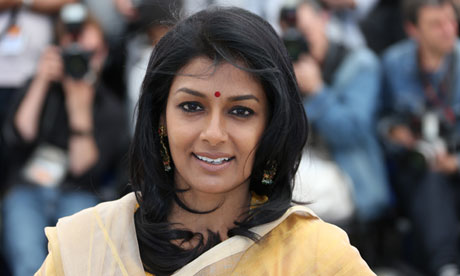The Dark is Beautiful campaign hopes to halt India’s huge appetite for skin whitening products, and has a new champion in film star Nandita Das
Nandita Das: ‘Indians are very racist. There is so much pressure that perpetuates this idea that fair is the ideal.’ Photograph: Loic Venance/AFP/Getty Images
“You look green!” said a friend. “Are you ill?” asked another. Last year, a respected Indian newspaper published a photograph of me online which had been lightened so drastically by the art director’s magic wand that I called the editor to complain and he apologised and replaced it with the original. The art director had thought he?was doing me a favour by whitening my skin.
India‘s obsession with fair skin is well documented: in 1978, Unilever launched Fair & Lovely cream, which has subsequently spawned numerous whitening face cleansers, shower gels and even vaginal washes that claim to lighten the surrounding skin. In 2010, India’s whitening-cream market was worth $432m, according to a report by market researchers ACNielsen, and was growing at 18% per year. Last year, Indians reportedly consumed 233 tonnes of skin-whitening products, spending more money on them than on Coca-Cola.
Cricket players and Bollywood stars regularly endorse these products. But now the film star?Nandita Das?has taken a stance against the craze and given her support to the?Dark is Beautiful?campaign which challenges the belief that success and?beauty?are determined by skin colour. “I want people to be comfortable in their own skin and?realise that there is more to life than skin colour,” she says, adding that an Indian paper had written “about my support for the campaign and then lightened the photo of me that went alongside it”.
While she agrees that there is a long history behind the obsession with skin colour, owing to caste and culture, she thinks the current causes should be targeted first. “Indians are very racist. It’s deeply ingrained. But there is so much pressure by peer groups, magazines, billboards and TV adverts that perpetuate this idea that fair is the ideal,” she says.
Das has often faced directors and makeup artists trying to lighten her when she plays the role of an educated, upper-class woman. “They always say to me: ‘Don’t worry, we will lighten you, we’re really good at it,’ as a reassurance. It’s perpetuating a stereotype that only fair-skinned women can be educated and successful.”
In 2005, the cosmetics company Emami launched Fair & Handsome for men, with an ad featuring the Bollywood star Shah Rukh Khan tossing a tube of whitening cream to a hopeful young fan, which the?Dark is Beautiful campaign is?seeking to have withdrawn. “Shah Rukh Khan is saying that to be successful you have to be fair,” says Das. “Don’t these people have any kind of conscience? You can’t be naive; you know what kind of impact you have and?yet you send out the message that says: ‘Forget about working hard, it’s about skin colour.'”
India‘s obsession with fair skin is well documented: in 1978, Unilever launched Fair & Lovely cream, which has subsequently spawned numerous whitening face cleansers, shower gels and even vaginal washes that claim to lighten the surrounding skin. In 2010, India’s whitening-cream market was worth $432m, according to a report by market researchers ACNielsen, and was growing at 18% per year. Last year, Indians reportedly consumed 233 tonnes of skin-whitening products, spending more money on them than on Coca-Cola.
Cricket players and Bollywood stars regularly endorse these products. But now the film star?Nandita Das?has taken a stance against the craze and given her support to the?Dark is Beautiful?campaign which challenges the belief that success and?beauty?are determined by skin colour. “I want people to be comfortable in their own skin and?realise that there is more to life than skin colour,” she says, adding that an Indian paper had written “about my support for the campaign and then lightened the photo of me that went alongside it”.
While she agrees that there is a long history behind the obsession with skin colour, owing to caste and culture, she thinks the current causes should be targeted first. “Indians are very racist. It’s deeply ingrained. But there is so much pressure by peer groups, magazines, billboards and TV adverts that perpetuate this idea that fair is the ideal,” she says.
Das has often faced directors and makeup artists trying to lighten her when she plays the role of an educated, upper-class woman. “They always say to me: ‘Don’t worry, we will lighten you, we’re really good at it,’ as a reassurance. It’s perpetuating a stereotype that only fair-skinned women can be educated and successful.”
In 2005, the cosmetics company Emami launched Fair & Handsome for men, with an ad featuring the Bollywood star Shah Rukh Khan tossing a tube of whitening cream to a hopeful young fan, which the?Dark is Beautiful campaign is?seeking to have withdrawn. “Shah Rukh Khan is saying that to be successful you have to be fair,” says Das. “Don’t these people have any kind of conscience? You can’t be naive; you know what kind of impact you have and?yet you send out the message that says: ‘Forget about working hard, it’s about skin colour.'”

